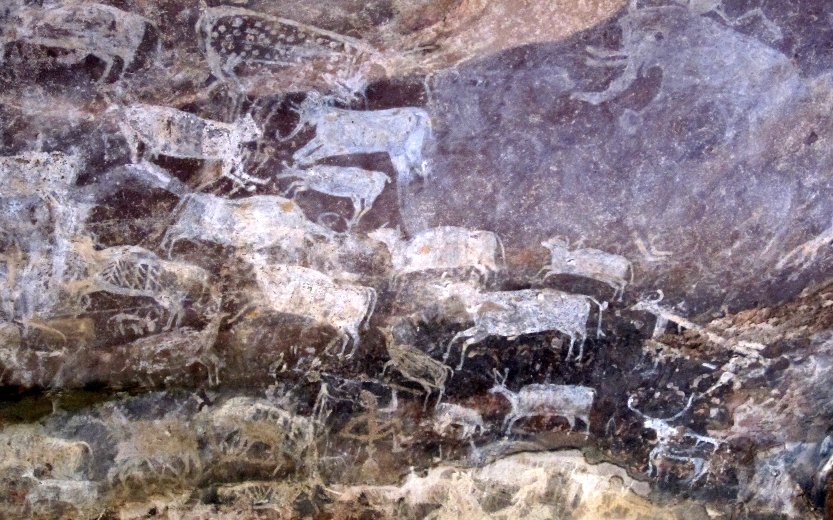Bhimbetka: Gigantic Open Air Repository Of Prehistoric Art In India
A. Sutherland - AncientPages.com - Among the richest and best documented ancient sites in India, there are rock shelters of Bhimbetka located in Raisen district, approximately 45 kilometers south-east of Bhopal in west-central Madhya Pradesh state.
It is one of the largest repositories of prehistoric art in India.
Excavations carried out at Bhimbetka have revealed occupational deposits dated from the Acheulian period, which lasted from 1.5 million to 200,000 years ago to present times.
Bhimbetka (today a UNESCO World Heritage site) was first mentioned in Indian archaeological records in 1888 as a Buddhist site, and in 1957, several prehistoric rock shelters were discovered and presented to the world by an Indian archeologist, V.-S. Wakankar.
The site spread over 10 km in length and about 3 km in width has more than 700 rock shelters, of which over 400 have paintings. Many artifacts have been discovered, such as cleavers, pebble tools and handaxes, which testify to the earliest human activities in this region of India.
Categorized into different prehistoric periods, the Bhimbetka paintings show great vitality, amazingly created impact of motion of presented figures and extraordinary narrative skill of the unknown ancient artists.
Some of the paintings belong to a period earlier than five thousand years and may be as old as 10,000 years.
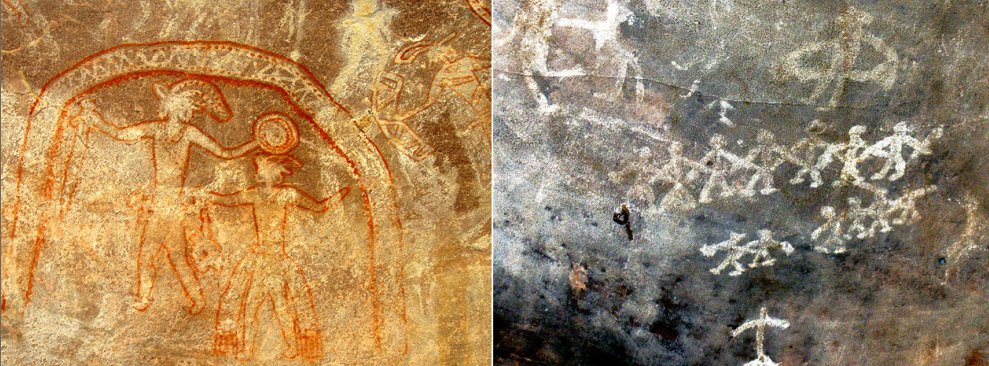
The colors used are vegetable colors which have endured through time because the drawings were generally made deep inside a niche or on inner walls. Image: Bradshowfoundation
Paintings from Middle Stone Age (roughly 12,000 to 5,000 BC) are smaller and portray both animals and human activities. Drawings from the early Bronze Age display the early humans' visions of agriculture.
Finally, the decorative paintings dating to early historical times from 2,500 BC onwards depict religious motifs, including tree gods and magical sky chariots.
There are simple line drawings made in single color to more advanced depictions expressed in several colors; there are depictions of elephants and horses and human figures on horsebacks and equipped with swords and shields. The Mesolithic artists of Bhimbetka knew as many as 21 colors but their favorite colors were red and white.
There are also scenes showing warriors attacking each other and large hords of running animals.
See also:
Mystery Of 1,000 Ancient Carved Shiva Lingas Discovered In India And Cambodia
Ajanta Caves: Incredible Accomplishment Of India’s Ancient Stonecutters
Ezhuthala Cave With Prehistoric Paintings In Kerala’s Sandalwood Forests In India
Archaeologists say that Bhimbetka's paintings were a script for communication, called pictorial script before the evolution of vocal language. The rocks have incredible shapes in several stunning hues and textures. This spectacular background makes the rock art even more fascinating.
The smooth shape of the rocks has led some scientists to believe that the area was once under water.
The rock art at Bhimbetka evolved over several millennia.
Written by – A. Sutherland AncientPages.com Staff Writer
Copyright © AncientPages.com All rights reserved. This material may not be published, broadcast, rewritten or redistributed in whole or part without the express written permission of AncientPages.com
Expand for referencesMore From Ancient Pages
-
 Human Activities In The Year 1300 Impacted Earth’s Atmosphere More Than Previously Known
Archaeology | Oct 9, 2021
Human Activities In The Year 1300 Impacted Earth’s Atmosphere More Than Previously Known
Archaeology | Oct 9, 2021 -
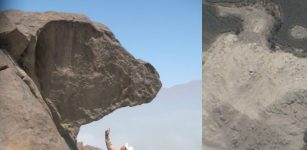 Rare Animal-Shaped Mounds Discovered In Peru
Archaeology | Apr 2, 2012
Rare Animal-Shaped Mounds Discovered In Peru
Archaeology | Apr 2, 2012 -
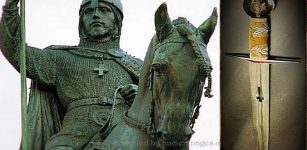 Prince Wenceslaus Of Bohemia Murdered On Order Of His Own Brother
Featured Stories | Nov 19, 2019
Prince Wenceslaus Of Bohemia Murdered On Order Of His Own Brother
Featured Stories | Nov 19, 2019 -
 How And When Did Ancient People Start Using Oil?
Ancient History Facts | Jun 28, 2018
How And When Did Ancient People Start Using Oil?
Ancient History Facts | Jun 28, 2018 -
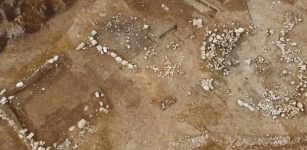 Bronze Age Roundhouses And Roman-Era Settlement Discovered In Newquay, Cornwall
Archaeology | Apr 11, 2023
Bronze Age Roundhouses And Roman-Era Settlement Discovered In Newquay, Cornwall
Archaeology | Apr 11, 2023 -
 Ancient Peru’s Cranial Surgeons Had Remarkable Skills
Ancient Technology | Jun 8, 2018
Ancient Peru’s Cranial Surgeons Had Remarkable Skills
Ancient Technology | Jun 8, 2018 -
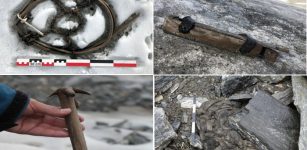 Rare Viking Artifacts Hidden Beneath The Ice Discovered By Archaeologists In Norway
Archaeology | Feb 6, 2021
Rare Viking Artifacts Hidden Beneath The Ice Discovered By Archaeologists In Norway
Archaeology | Feb 6, 2021 -
 Why Did We Abandon Roman Numerals?
Ancient History Facts | Apr 25, 2019
Why Did We Abandon Roman Numerals?
Ancient History Facts | Apr 25, 2019 -
 Is There An Ancient Anomaly In Our DNA? It Is Possible, Scientists Say
Featured Stories | Mar 6, 2025
Is There An Ancient Anomaly In Our DNA? It Is Possible, Scientists Say
Featured Stories | Mar 6, 2025 -
 Rare 500-Year-Old Wreck From Missing Ship Samson Discovered In Central Stockholm, Sweden
Archaeology | Dec 20, 2019
Rare 500-Year-Old Wreck From Missing Ship Samson Discovered In Central Stockholm, Sweden
Archaeology | Dec 20, 2019 -
 Hina Matsuri Festival – Sending Dolls In Boats Into The Ocean To Celebrate Girl’s Day In Japan – Ancient Shinto Tradition
Ancient History Facts | Mar 3, 2025
Hina Matsuri Festival – Sending Dolls In Boats Into The Ocean To Celebrate Girl’s Day In Japan – Ancient Shinto Tradition
Ancient History Facts | Mar 3, 2025 -
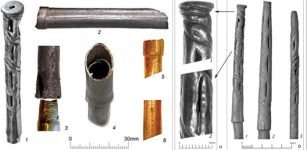 Oldest Surviving Drinking Straws Identified – ‘Sceptres’ From The Maikop Kurgan
Archaeology | Jan 19, 2022
Oldest Surviving Drinking Straws Identified – ‘Sceptres’ From The Maikop Kurgan
Archaeology | Jan 19, 2022 -
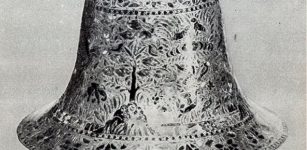 Enigma Of Ancient Bell-Shaped Metal Vase Found In Solid Sedimentary Rock
Artifacts | Jun 6, 2019
Enigma Of Ancient Bell-Shaped Metal Vase Found In Solid Sedimentary Rock
Artifacts | Jun 6, 2019 -
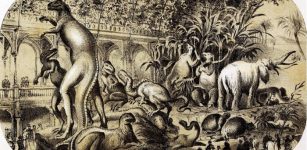 New Study Reveals Who Destroyed New York’s First Dinosaur Museum
News | May 29, 2023
New Study Reveals Who Destroyed New York’s First Dinosaur Museum
News | May 29, 2023 -
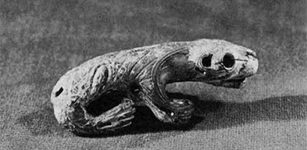 Ancient City Of Ipiutak Was Built By A Fair-Haired Race With Blue Eyes And Not Us – The Inuit Say
Featured Stories | Apr 23, 2019
Ancient City Of Ipiutak Was Built By A Fair-Haired Race With Blue Eyes And Not Us – The Inuit Say
Featured Stories | Apr 23, 2019 -
 Unique Historical Discovery – Wreck Of Vasa’s Sister Ship Äpplet Found Off Swedish Coast!
Archaeology | Oct 25, 2022
Unique Historical Discovery – Wreck Of Vasa’s Sister Ship Äpplet Found Off Swedish Coast!
Archaeology | Oct 25, 2022 -
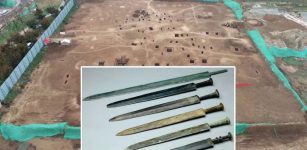 Well-Preserved Warring States Period Swords And Cultural Relics Discovered In Xiangyang, Hubei
Archaeology | Apr 5, 2024
Well-Preserved Warring States Period Swords And Cultural Relics Discovered In Xiangyang, Hubei
Archaeology | Apr 5, 2024 -
 Unsolved Mystery Of The Huldremose Woman: One Of The Best Preserved Bog Bodies Ever Found
Civilizations | Jan 9, 2017
Unsolved Mystery Of The Huldremose Woman: One Of The Best Preserved Bog Bodies Ever Found
Civilizations | Jan 9, 2017 -
 Evidence Foreigners Fought Alongside Ancient Greeks Is Challenging Millennia Of Military History
Featured Stories | Jun 1, 2022
Evidence Foreigners Fought Alongside Ancient Greeks Is Challenging Millennia Of Military History
Featured Stories | Jun 1, 2022 -
 Surprising Evolution Discovery – Extinct Subterranean Human Species With Tiny Brains Used Fire
Archaeology | Dec 9, 2022
Surprising Evolution Discovery – Extinct Subterranean Human Species With Tiny Brains Used Fire
Archaeology | Dec 9, 2022



